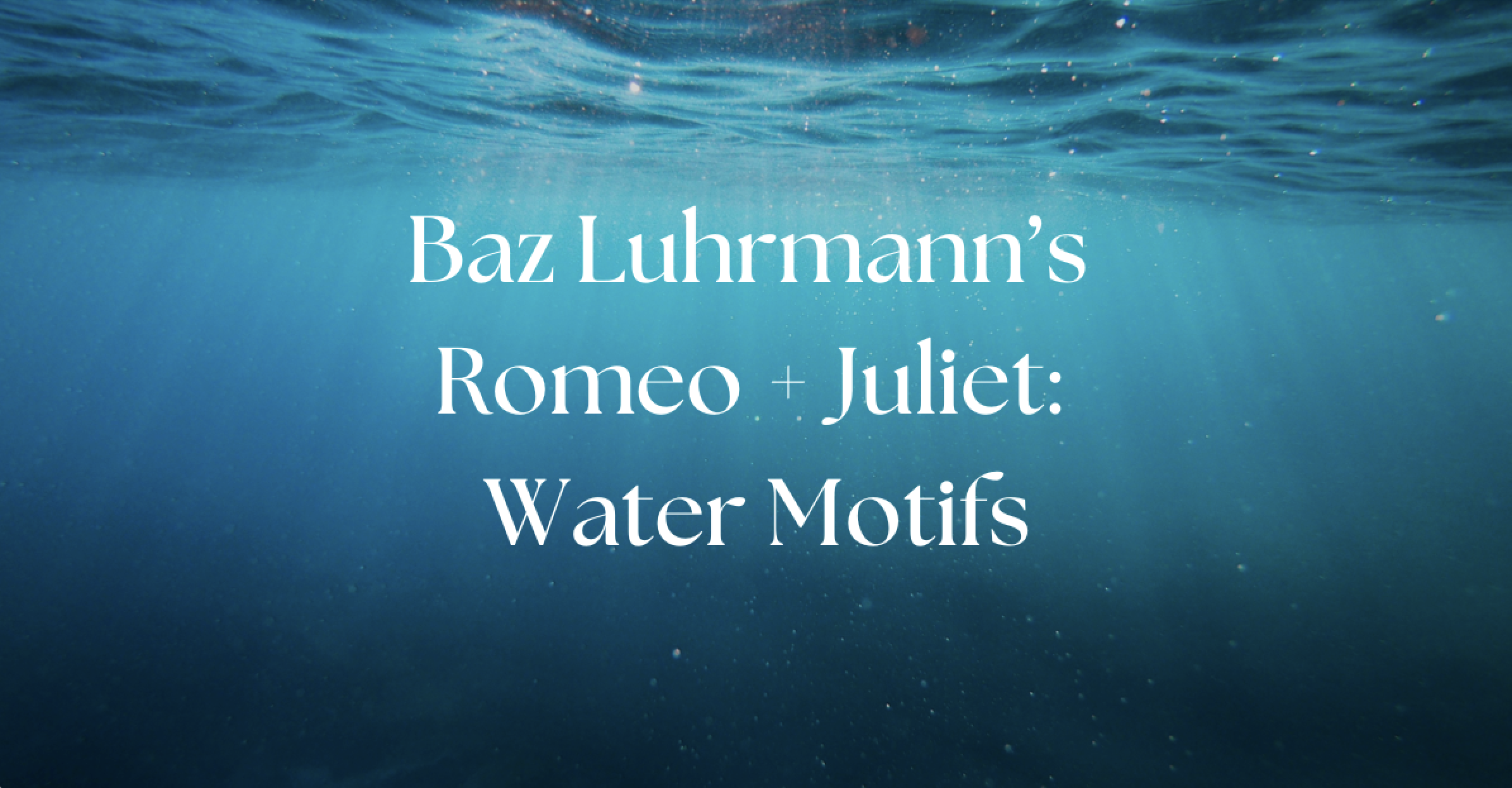Because everyone loves a good story
Baz Luhrmann’s Romeo + Juliet: Water Motifs

In the world of film, there are plenty of recurring motifs: light, darkness, time, seasons, weather, and colors, to name a few. But one of the most common is that of water. It’s prevalent as a motif because it can have so many different meanings based on the context.
In Baz Luhrmann’s Romeo + Juliet, the director uses water as one of his major motifs. But instead of using it to signify a single truth, he uses water’s changeable nature to depict the opposing forces of peace and death. These seeming opposites actually go hand-in-hand in many ways, and Luhrmann capitalizes on this truth. Both calm water and turbulent water—and even lack of water—add a depth of meaning to the film.
Calm Water Communicates Peace
Toward the beginning of the movie, we see hectic preparations for a costume party at the Capulet mansion. Decorations are being set up, food is being delivered, and Lady Capulet is rushing around half dressed, yelling her head off for Juliet. Meanwhile, young Juliet is submerged in her bathtub, blissfully unaware of the chaos. We see her serene face under water, her hair swirling slowly around her. In fact, she almost looks dead. But she’s found peace in the chaos.
Later on, Mercutio gives Romeo a pill that intensifies the dizzying madness of the Capulets’ party. To clear his head, Romeo submerges his face in a sink full of water. It’s a clear echo of Juliet’s underwater peace earlier in the movie. When he stands up, he sees Juliet through a big tropical fish tank. The beautiful fish are swimming peacefully together, but Romeo and Juliet are separated by the wall.
Soon, however, the two lovers are swimming peacefully together in the Capulets’ pool. Romeo professes his undying love to Juliet, and although she’s worried about the families’ reactions if they find out, she returns his confession of love. But we know a storm is coming. The lovers embrace underwater, submerged and at peace, enjoying the calm before the storm.
Heat Highlights Unrest

So if calm water communicates peace, a lack of water points to uneasiness. This tension is palpable in several scenes. After the prologue, the very first scene we encounter is a fight between the Montague and Capulet boys. There’s no peace here; rather than calm water, we see images of heat and fire. It’s a sultry summer day. Tybalt is smoking throughout the scene, and his smoldering cigarette sets fire to spilled gasoline and lights up the whole gas station—aptly named Phoenix Gas. The spark of this fight ignites the anger and tension that intensifies throughout the film.
The story is set in Verona Beach, and you can tell it’s a sweltering town. But the dry heat escalates exponentially when Romeo is banished to Mantua. While Verona Beach is right on the water, Mantua is a desert. It’s hot, dry, and dusty. Everything is parched. Because of Romeo’s foolish choices, he’s been banished from his city and his bride. There is no peace here. The arid climate reflects the unrest of Romeo’s heart.
Turbulent Water Reflects Death
The unrest in Mantua is preceded by disaster in Verona. A fight on the beach begins as threats and accusations but ends in two murders. Tybalt (Juliet’s cousin) stabs Mercutio (Romeo’s friend.) Romeo takes revenge by shooting Tybalt. As this scene unfolds, dark clouds roll in, thunder rumbles, and wind howls. But as soon as Romeo pulls the trigger to shoot Tybalt, the rains descend. Death has overwhelmed peace.

In the first scene, Tybalt says to Benvolio Montague, “What, drawn [your sword] and talk of peace? I hate the word/ as I hate hell, all Montagues, and thee.” Mercutio refers to Tybalt as the “prince of cats” because he’s fierce and apt to “scratch” with his sword. We always see Tybalt smoking and brooding. But when Tybalt finally gets killed, he falls backward at the feet of a giant Jesus statue, Tybalt’s arms outstretched in the shape of a cross. His body plunges into a pool of water and is still. His quarrelsome soul is finally at peace.
But at that moment, the clouds open up and unleash a pouring torrent of rain on Romeo, the murderer. There will be no peace for him, and more death will come from his actions.
The Final Peace
Romeo and Juliet secretly spend their wedding night together in Juliet’s bedroom. In the morning, though, Romeo has to sneak away to Mantua because of his banishment. As he’s climbing out her window, he falls into the pool below. Juliet sees him from her balcony and considers how he looks dead at the bottom of a tomb. Her premonition won’t be unfulfilled for long.
The star-crossed lovers take their lives in the silent, lonely church. They lie together on their death bed, united at last. Luhrmann flashes back to the times when they were happy and in love, and his final shot is of the young lovers kissing underwater the first night they met. Together in death; together in peace. The families’ foolish fighting can’t separate them anymore.
A Glooming Peace
The epilogue declares that “a glooming peace” has settled over the families. The prince lectures them, observing, “See what a scourge is laid upon your hate,/That heaven finds means to kill your joys with love.” The families vow to honor the memory of the lovers and drop the feud at long last. It’s too late for Romeo and Juliet in life, but they’re finally together and at peace in death.
While the story itself is powerful, the imagery of Luhrmann’s film adds another layer to the enjoyment. The movie is strange enough to lack universal popularity, but I’m always a fan of a good retelling. I say hats off to you and your motifs, Mr. Luhrmann.




Add a comment, and join the conversation!